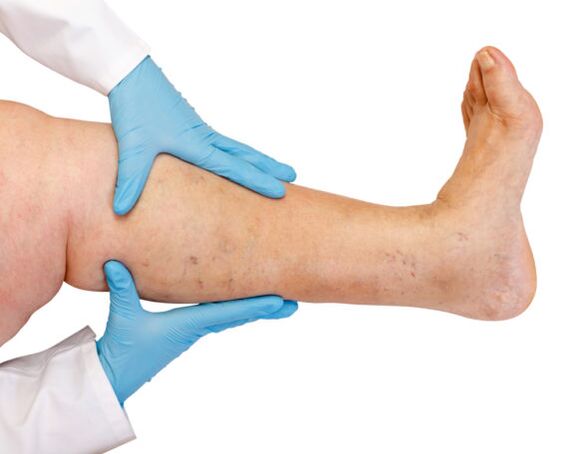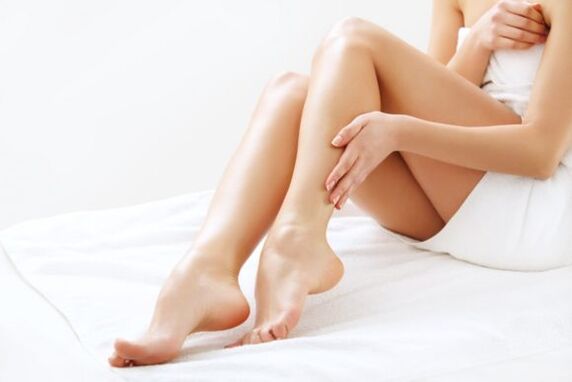As long as you read the article, you come across a problem like varicose veins.Internal varicose veins are a common and familiar disease for men and women.The article below discusses the manifestations of the disease, diagnostic methods and information on how to cure internal varicose veins in the legs.

Symptoms
In a healthy state, leg veins are virtually not visible, they are hidden under the skin and work normally, without providing problems to a person.But with a disease like internal leg varicose veins, you can observe an extended venous mesh with nodes and in advanced cases with trophic ulcers.
Varicosis is not only a cosmetic defect, but also a very dangerous disease that should be detected in the early stages and consult a phlebologist.The vein varicose in the limbs occurs due to blood stagnation with a violation of the function of venous valves, which helps blood rise in the heart and not decrease.
Symptoms of deep veins, which should pay attention:
- pigmentation, dryness, burning at the lower ends;
- swelling and severity for or at the end of the day;
- Pain at the lower ends;
- The appearance of a venous grid extended on the legs.

At the beginning of the disease, it is easy to win, but advanced cases are full of complications.
Internal varicose veins in the legs can cause the appearance of trophic ulcers that bleed and cure for a long time, and the most dangerous consequence of the pathology is the formation of blood clots.
A thrombus at any moment can break and clog important vessels, which can lead to death.Therefore, there is no need to ignore such an insignificant disease at first glance.
The varicose veins in the legs have a genetic predisposition.If the closest relatives have such a condition, be careful and perform preventive measures.
Reasons
The reasons for the appearance of a vascular mesh can be:
- excessive leg load;
- obesity;
- hormone therapy;
- Pregnancy or menopause;
- inconvenient shoes;
- A long stay on the legs (standing or at work and lifestyle).
The internal expansion of the veins of the lower extremities is clearly portrayed in the photo.
Stages, of course
The stages of disease development are as follows:
- 1st Stage: A person practically does not pay attention to his condition, sometimes hesitates after a long walk or serious physical effort.
- 2nd Stage: By this time, the patient has already begun to swell, the pain intensifies, a network of varicoseosis appears, no night cramps are possible.
- 3rd Stage: The exacerba condition, the swelling of the legs is improved, the pigmentation appears, the veins expand even more and darken and the node of their knot can be seen.
- 4th Stage: There is an increase in body temperature and skin integrity is the disturbed trophic ulcers.This is the hardest and most dangerous stage.But most of the time, it is in this state that people resort to the doctor, ignoring their previous states.
How does the diagnosis of varicose veins pass?
Initially, an examination of the doctor is performed, in which the color and skin condition are evaluated, the presence of swelling and visualization of venous expansion in the legs are verified.
The next one is one of the following studies:

- The gold standard of diagnosis is the duplex-synography method.A modern ultrasonic method that provides detailed information on the state of deep and surface vessels.It only takes 20 minutes of time.Special patient preparation is not necessary.The diagnosis is made in the ultrasound puppy.
- Dopplerography.The method makes it possible to evaluate the nature of blood flow, the state of the valves of the perforating and deep veins, its cross capacity, the presence of blood clots.
- Flebography refers to X -ray methods of diagnosis.A good way to confirm the diagnosis, but requires the introduction of a contrast matter in Vienna, after which an x root is taken.
In the image, the doctor evaluates the cost of progress and the lumen stream and also determines the presence of blood clots.
Purchase samples (bandage) were previously used, but with modern technical resources, they rarely use them.
What treatment and prevention methods are effective?
Deep vein varicose from the lower extremities can and should be treated in a timely manner!Do not be afraid and do not hesitate to contact a phlebologist with this problem.In the early stages of the disease, you can get rid of ease and pain.
Initially, it is worth excluding the factors that can cause the disease:
- physical activity;
- inappropriate shoes;
- Overweight;
- Bad hormonal background.
But not all reasons can be adjusted, for example, pregnancy or heredity.In such cases, you need to remember prevention.
A good preventive method will be moderate physical effort (running cowardly, walking with elevators, swimming, cycling).But at the same time, don't forget to use compression linen.
You need to avoid overheating of the body, so delete baths, saunas and tanning.
Small errors during working hours as throwing your legs on your leg, long -standing your legs or sitting, will adversely affect the health of your veins, then follow your activity.
Get out of the workplace every half hour and punch, in the case of a long standing position, change the support leg.Arriving home, lie on the bed and lift your legs up - so that your members rest, the swelling will decrease.
Special Exercises
Patients with varicose veins can perform academic exercises to clean the blood vessels.
The patient needs to stand on the socks, lifting his heels 1 cm from the floor and then he will land dramatically on heels.You can repeat the 30-50 exercise (no more than 60!) Times 3-5 approaches per day.The rhythm is slow, but with a sharp landing.With a strong shock, the muscles of the hell and push blood into the heart.
Internal varicose veins in the legs are treated with systemic and surgical methods.

Drug therapy
Drug treatment will make it possible to overcome the disease in the early stages and avoid complications.
The medicines are prescribed to:
- Increase venous tone;
- Improve lymphatic drainage function (reduce stagnant phenomena);
- improve fabric nutrition;
- Stop the secondary inflammatory reactions.
Any medicines need to be taken only as prescribed by an expert!Do not self -assert, so as not to aggravate the state of your health.
Surgical treatment
The surgical method is used under advanced conditions.It consists of removing expanded subcutaneous veins and insolvent perfume.This is a more radical treatment method.There are still methods such as removal and connection.They also relate to surgery, but are performed on an outpatient patient.
Removal is the removal of an expanded vein using a small probe.Two small cuts are made at the beginning and end of the vessel, a tool is started and fixed on the output;Then the probe along with Vienna is eliminated.
Advantages of this method: minor cosmetic defects, a period of rapid recovery, lower pain after intervention.
LIGART - Bandaging Varicosy Veins, is practiced more as an additional method for removing or removing radicals.

Miniflebectomy is an operational intervention with minimal access: a special hook is introduced through the incision, pulls the vein out, where it is bandaged and cut.
What method of treatment resort to in your case - only one expert decides.
What does traditional medicine offer?
In folk medicine, squeezed juices of carrots, spinach leaves, beets, celery and parsley proved well.
You need to drink 500 ml daily.And special attention is given to the drink regime, since the blood plasma consists of water and other elements of trace.Lacking fluid, the blood is thickening.The Human Water Standard: 40 ml by 1 kg weight.
The internal expansion of the veins of the lower extremities is a serious but healed disease.Listen to your body, with the slightest violations, consult a doctor!












































